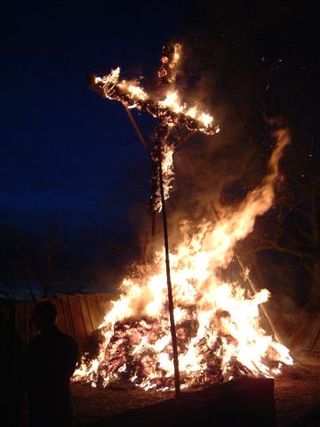Ahrweiler is a district in the north of Rhineland-Palatinate, Germany. It is bounded by the districts of Euskirchen, Rhein-Sieg and the city of Bonn in the state of North Rhine-Westphalia, and the districts of Neuwied, Mayen-Koblenz and Vulkaneifel.

The Rheinwiesenlager were a group of 19 concentration camps built in the Allied-occupied part of Germany by the U.S. Army to hold captured German soldiers at the close of the Second World War. Officially named Prisoner of War Temporary Enclosures (PWTE), they held between one and almost two million surrendered Wehrmacht personnel from April until September 1945.

Bad Neuenahr-Ahrweiler is a spa town in the German Bundesland of Rhineland-Palatinate that serves as the capital of the Ahrweiler district. The A61 motorway connects the town with cities like Cologne and Mainz. Formed by the merging of the towns of Bad Neuenahr and Ahrweiler in 1969, Bad Neuenahr-Ahrweiler consists of 11 such districts.

Ahr is a river in Germany, a left tributary of the Rhine. Its source is at an elevation of approximately 470 metres (1,540 ft) above sea level in Blankenheim in the Eifel, in the cellar of a timber-frame house near the castle of Blankenheim. After 18 kilometres (11 mi) it crosses from North Rhine-Westphalia into Rhineland-Palatinate.

Sinzig is a town in the district of Ahrweiler, in Rhineland-Palatinate, Germany. It is situated on the river Rhine, about 5 km south-east of Remagen and 25 km south-east of Bonn, and it has approximately 20,000 inhabitants (2004).

Ernst Wiechert was a German teacher, poet and writer.
The Amateurliga Rheinland was the highest football league in the region of the Rheinland Football Association and the third tier of the German football league system from its inception in 1952 to the formation of the Oberliga Südwest and the Verbandsliga Rheinland below it in 1978.

The Südkurier is a regional daily newspaper in Germany serving the regions northwest of Lake Constance, Hochrhein and Black Forest with its headquarters in Konstanz. The paper appears with a circulation of around 130,000, six times per week, in Berliner format. The predecessor of the Südkurier was the Konstanzer Zeitung.
Bad Breisig is an archaeological site in Germany.

The Ahr Valley Railway, Remagen–Ahrbrück, is currently a 29 km-long, partly single-track and non-electrified branch line, which runs through the Ahr valley from Remagen via Ahrweiler and Dernau to Ahrbrück in the German state of Rhineland-Palatinate. It is served by Regionalbahn services on lines RB 30 and RB 39.

The Ahr valley is named after the Ahr, a left tributary of the Rhine in Germany. It begins at the Ahr spring (Ahrquelle) in Blankenheim in the county of Euskirchen and runs generally eastwards. At its southernmost point it enters the county of Ahrweiler, and hence the state of Rhineland-Palatinate. Running through the collective municipality of Adenau the valley bends northeast at its confluence with the Adenauer Bach and reaches the collective municipality of Altenahr, from where it resumes its characteristic west to east course, albeit interrupted by meanders. Here begins the section that is known as the Ahr valley (Ahrtal) in a touristic sense. Here it is characterized by vineyards on the south-facing slopes and a picturesque rocky landscape, carved out by the river creating a 300 metre deep gorge in the Ahr Hills. In the next stage the Ahr reaches the area of the county town of Bad Neuenahr-Ahrweiler, before finally discharging into the Rhine south of Remagen in the borough of Sinzig.

The Golden Mile was an Allied POW camp in 1945 on the fertile Rhine plain known as the Golden Mile near Remagen in Germany.

Are Castle is the ruin of a hill castle that stands at a height of 240 m above sea level (NHN) above the village of Altenahr in the German state of Rhineland-Palatinate. It was built around 1100 by Count Dietrich I of Are and is first recorded in 1121.

Vincenz Statz was a Neo-Gothic German architect, mainly active in the Rhineland.

Elbe-Elster Land, also called the Elbe-Elster region (Elbe-Elster-Gebiet) is a region around the tripoint of the German states of Brandenburg, Saxony-Anhalt and Saxony. It is part of the North German Plain and is named after the two major rivers that have their confluence here: the Elbe and the Black Elster.

The Häuschen is a hill, 506.5 m above sea level (NHN), in the Eifel mountains. It rises near Ahrweiler in the county of Ahrweiler in the German state of Rhineland-Palatinate.

Hüttenbrennen, sometimes also referred to as Burgbrennen, is an old-fashioned bonfire custom in many part of the Eifel mountains in Germany. It is celebrated every year on "Straw Sunday", the first Sunday after Shrove Tuesday, also observed as Funkensonntag.
Ernst Klusen was a German musicologist, educator and Volkslied composer.

Marie-Luise Millowitsch is a German actress.

The Wingsbach is a small right tributary of the Ahr river. It has a length of 4.5 km and a drainage area of 5.4 km2. Colloquially it is also referred to as Maibach and in its upper course is also named Talbach.
This page is based on this
Wikipedia article Text is available under the
CC BY-SA 4.0 license; additional terms may apply.
Images, videos and audio are available under their respective licenses.

















